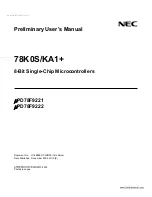
Still not Working
A mistake we made a time or
two was simply forgetting to
connect the power (red and
brown wires) to +5 volts and
ground.
15
CIRC-04
Code
(no need to type everything in just)
File > Examples > Servo > Sweep
(example from the great arduino.cc site check it out for other great ideas)
Not Working?
(3 things to try)
More, More, More:
More details, where to buy more parts, where to ask more questions.
http://tinyurl.com/djwlop
Making it Better
Servo Not Twisting?
Even with colored wires it is still
shockingly easy to plug a servo
in backwards. This might be the
case.
Potentiometer Control:
void loop() {
We have yet to experiment with inputs but if you would like to
int pulseTime = 2100; //(the number of microseconds
//to pause for (1500 90 degrees
read ahead, there is an example program
File > Examples >
// 900 0 degrees 2100 180 degrees)
digitalWrite(servoPin, HIGH);
Servo > Knob.
This uses a potentiometer (CIRC08) to control
delayMicroseconds(pulseTime);
digitalWrite(servoPin, LOW);
the servo. You can find instructions online here:
delay(25);
http://tinyurl.com/dymsk2
}
Great Ideas:
Self Timing:
Servos can be used to do all sorts of great things, here are a few of
While it is easy to control a servo using the Arduino's included
our favorites.
library sometimes it is fun to figure out how to program
something yourself. Try it. We're controlling the pulse directly
Xmas Hit Counter
so you could use this method to control servos on any of the
http://tinyurl.com/37djhq
Arduino's 20 available pins (you need to highly optimize this
code before doing that).
Open Source Robotic Arm (uses a servo controller as well as the Arduino)
http://tinyurl.com/ckm3wd
int servoPin = 9;
void setup(){
Servo Walker
pinMode(servoPin,OUTPUT);
http://tinyurl.com/da5jfe
}
// Sweep
// by BARRAGAN <http://barraganstudio.com>
#include <Servo.h>
Servo myservo; // create servo object to control a servo
int pos = 0; // variable to store the servo position
void setup() {
myservo.attach(9); // attaches the servo on pin 9 to the servo object
}
void loop() {
for(pos = 0; pos < 180; pos += 1) // goes from 0 degrees to 180 degrees
{ // in steps of 1 degree
myservo.write(pos); // tell servo to go to position in variable 'pos'
delay(15); // waits 15ms for the servo to reach the position
}
for(pos = 180; pos>=1; pos-=1) // goes from 180 degrees to 0 degrees
{
myservo.write(pos); // tell servo to go to position in variable 'pos'
delay(15); // waits 15ms for the servo to reach the position
}
}
14
CIRC-04
What We’re Doing:
.:A Single Servo:.
.:Servos:.
Spinning a motor is good fun but when it comes to projects
where motion control is required they tend to leave us wanting
more. The answer? Hobby servos. They are mass produced,
widely available and cost anything from a couple of dollars to
hundreds. Inside is a small gearbox (to make the movement more powerful) and some
electronics (to make it easier to control). A standard servo is positionable from 0 to 180
degrees. Positioning is controlled through a timed pulse, between 1.25 milliseconds (0 degrees)
and 1.75 milliseconds (180 degrees) (1.5 milliseconds for 90 degrees). Timing varies between
manufacturer. If the pulse is sent every 25-50 milliseconds the servo will run smoothly. One of
the great features of the Arduino is it has a software library that allows you to control two
servos (connected to pin 9 or 10) using a single line of code.
The Circuit:
Wire
3 Pin Header
x1
Mini Servo
x1
2 Pin Header
x4
CIRC-04
Breadboard sheet
x1
Parts:
Schematic:
Arduino
pin 9
gnd
(ground) (-)
gnd
(black/
brown)
signal
(orange)
+5v
(red)
Mini Servo
+5 volts
(5V)
Fits and Starts
If the servo begins moving then
twitches, and there's a flashing
light on your Arduino board, the
power supply you are using is
not quite up to the challenge.
Using a 9V battery instead
should solve this problem.
.:download:.
breadboard layout sheet
http://tinyurl.com/db5fcm
.:view:.
assembling video
http://tinyurl.com/d52954
The Internet
















































